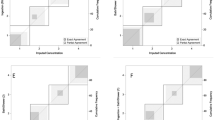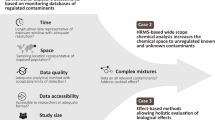Abstract
The variability of trihalomethane (THM) levels in drinking water raises the question of whether or not short-term variations (within-day) should be accounted for when assessing exposure to contaminants suspected of being carcinogenic and reprotoxic agents. The purpose of this study was to determine the magnitude of the impact on predicted biological levels of THMs (internal doses) exerted by within-day variations of THMs in drinking water. A database extracted from a campaign in the Québec City distribution system served to produce 81, 79 and 64 concentration profiles for the three most abundant THMs, namely chloroform (TCM), dichlorobromomethane (DCBM) and chlorodibromomethane (CDBM), respectively. Using a physiologically based toxicokinetic modeling approach, we simulated exposures (1.5 l water per day and a 10-min shower) based on each of these profiles and predicted, for 2000 individuals (Monte-Carlo simulations), maximum blood concentrations (Cmax), areas under the time versus blood concentrations curve (24 h-AUCcv) and total absorbed doses (ADs). Three different hypotheses were tested: [A] assuming a constant THM concentration in water (e.g., mean value of a day); [B] accounting for within-day variations in THM levels; and [C] a worst-case scenario assuming within-day variations and showering while THM levels were maximal. For each exposure profile, exposure indicator and individual, we calculated the ratios of values obtained according to each hypothesis (e.g., CmaxB/CmaxA and CmaxC/CmaxA) and the values corresponding to the 5th and 95th percentiles of these ratios. The closer these percentiles are to the value of 1, the smaller the error associated with assuming constant THM concentrations rather than their actual variability. Results showed that the minimal gap between these percentiles was TCM–AD(B)/TCM–AD(A) (5th=0.91; 95th=1.09), whereas the maximal gap was CDBM–Cmax(C)/CDBM–Cmax(A) (5th=0.50; 95th=3.40). Overall, TCM and ADs were the less affected (TCM<DCBM<CDBM and AD<AUCcv<Cmax) when accounting for within-day variations in water levels.
This is a preview of subscription content, access via your institution
Access options
Subscribe to this journal
Receive 6 print issues and online access
$259.00 per year
only $43.17 per issue
Buy this article
- Purchase on Springer Link
- Instant access to full article PDF
Prices may be subject to local taxes which are calculated during checkout



Similar content being viewed by others
References
Backer LC, Ashley DL, Bonin MA, Cardinali FL, Kieszak SM, Wooten JV . Household exposures to drinking water disinfection by-products: whole blood trihalomethane levels. J Expo Anal Environ Epidemiol 2000; 10: 321–326.
Haddad S, Charest-Tardif GC, Tardif R . Development of physiologically based toxicokinetic models for improving the human indoor exposure assessment to water contaminants: trichloroethylene and trihalomethanes. J Toxicol Environ Health A 2006; 69: 2095–2136.
Lynberg M, Nuckols JR, Langlois P, Ashley D, Singer P, Mendola P et al Assessing exposure to disinfection by-products in women of reproductive age living in Corpus Christi, Texas, and Cobb County, Georgia: descriptive results and methods. Environ Health Perspect 2001; 109: 597–604.
Nieuwenhuijsen MJ, Toledano MB, Elliott P . Uptake of chlorination disinfection by-products; a review and a discussion of its implications for exposure assessment in epidemiological studies. J Expo Anal Environ Epidemiol 2000; 10: 586–599.
Nuckols JR, Ashley DL, Lyu C, Gordon SM, Hinckley AF, Singer P . Influence of tap water quality and household water use activities on indoor air and internal dose levels of trihalomethanes. Environ Health Perspect 2005; 113: 863–870.
U.S.E.P.A. Exposure and Internal Doses of Trihalomethanes in Humans: Multi-Route Contributions from Drinking Water. National Center for Environmental Assessment: Cincinnati, OH. 1974, report no. EPA 600/R-06/087.
Villanueva CM, Cantor KP, Grimalt JO, Castano-Vinyals G, Malats N, Silverman D et al Assessment of lifetime exposure to trihalomethanes through different routes. Occup Environ Med 2006; 63: 273–277.
Wallace LA . Human exposure and body burden for chloroform and other trihalomethanes. Crit Rev Environ Sci Technol 1997; 27: 113–194.
Weisel CP, Jo WK . Ingestion, inhalation, and dermal exposures to chloroform and trichloroethene from tap water. Environ Health Perspect 1996; 104: 48–51.
Legay C, Rodriguez MJ, Serodes JB, Levallois P . The assessment of population exposure to chlorination by-products: a study on the influence of the water distribution system. Environ Health 2010; 9: 59.
Richter W, Hart TF, Luben T, Freud S, Nuckols JR . Evaluation of two methods of interpolating quarterly trihalomethane levels between sampling dates. J Expo Sci Environ Epidemiol 2009; 19: 405–413.
Rodriguez MJ, Serodes JB . Spatial and temporal evolution of trihalomethanes in three water distribution systems. Water Res 2001; 35: 1572–1586.
Rodriguez MJ, Serodes JB, Levallois P . Behavior of trihalomethanes and haloacetic acids in a drinking water distribution system. Water Res 2004; 38: 4367–4382.
Rodriguez MJ, Vinette Y, Serodes JB, Bouchard C . Trihalomethanes in drinking water of greater Quebec region (Canada): occurrence, variations and modelling. Environ Monit Assess 2003; 89: 69–93.
Singer PC, Obolensky A, Greiner A . DBPs in chlorinated North Carolina drinking waters. J AWWA 1995; 87: 83–92.
Tardif R, Haddad S, Catto C, Hamelin G, Rodriguez M . Modeling exposure to disinfection by products. In: Nriagu J (ed). Encyclopedia of Environmental Health. Elsevier: Burlington. 2011 pp 810–819.
Catto C, Rodriguez M, Tardif R . Accounting for the impact of short-term variations in trihalomethane drinking water levels on exposure assessment for epidemiological purposes? Part I: environmental aspects. submitted.
Krishnan K, Andersen ME . Physiologically based pharmacokinetic and toxicokinetic models. In: Hayes AW (ed). Principles and Methods of Toxicology. CRC Press, Tayler and Francis Group: New York, 2008, pp 231–292.
Sari-Minodier I, Truchon G, Charest-Tardif G, Berube A, Tardif R . The effect of workload on biological monitoring of occupational exposure to toluene and n-Hexane: contribution of physiologically based toxicokinetic modeling. J Occup Environ Hyg 2009; 6: 415–432.
Berthet A, de Batz A, Tardif R, Charest-Tardif G, Truchon G, Vernez D et al Impact of biological and environmental variabilities on biological monitoring--an approach using toxicokinetic models. J Occup Environ Hyg 2010; 7: 177–184.
Tardif R, Droz PO, Charest-Tardif G, Pierrehumbert G, Truchon G . Impact of human variability on the biological monitoring of exposure to toluene: I. Physiologically based toxicokinetic modelling. Toxicol Lett 2002; 134: 155–163.
Truchon G, Tardif R, Droz PO, Charest-Tardif G, Pierrehumbert G . Biological exposure indicators: quantification of biological variability using toxicokinetic modeling. J Occup Environ Hyg 2006; 3: 137–143.
Valcke M, Krishnan K . An assessment of the interindividual variability of internal dosimetry during multi-route exposure to drinking water contaminants. Int J Environ Res Public Health 2010; 7: 4002–4022.
Batterman S, Zhang L, Wang S, Franzblau A . Partition coefficients for the trihalomethanes among blood, urine, water, milk and air. Sci Total Environ 2002; 284: 237–247.
Tan YM, Liao KH, Clewell HJ . Reverse dosimetry: interpreting trihalomethanes biomonitoring data using physiologically based pharmacokinetic modeling. J Expo Sci Environ Epidemiol 2007; 17: 591–603.
Corley RA, Mendrala AL, Smith FA, Staats DA, Gargas ML, Conolly RB et al Development of a physiologically based pharmacokinetic model for chloroform. Toxicol Appl Pharmacol 1990; 103: 512–527.
Costeff H . A simple empirical formula for calculating approximate surface area in children. Arch Dis Child 1966; 41: 681–683.
Acknowledgements
We acknowledge the Réseau de recherche en santé environnementale (Québec) for funding. We thank Tarik Sadik for conducting the sampling campaigns. We also thank Jérôme Lavoué for his advice and Ms Janet Brownlee for idiomatic corrections.
Author information
Authors and Affiliations
Corresponding author
Ethics declarations
Competing interests
The authors declare no conflict of interest.
Rights and permissions
About this article
Cite this article
Catto, C., Charest-Tardif, G., Rodriguez, M. et al. Accounting for the impact of short-term variations in the levels of trihalomethane in drinking water on exposure assessment for epidemiological purposes. Part II: Biological aspects. J Expo Sci Environ Epidemiol 23, 60–66 (2013). https://doi.org/10.1038/jes.2012.88
Received:
Accepted:
Published:
Issue Date:
DOI: https://doi.org/10.1038/jes.2012.88



